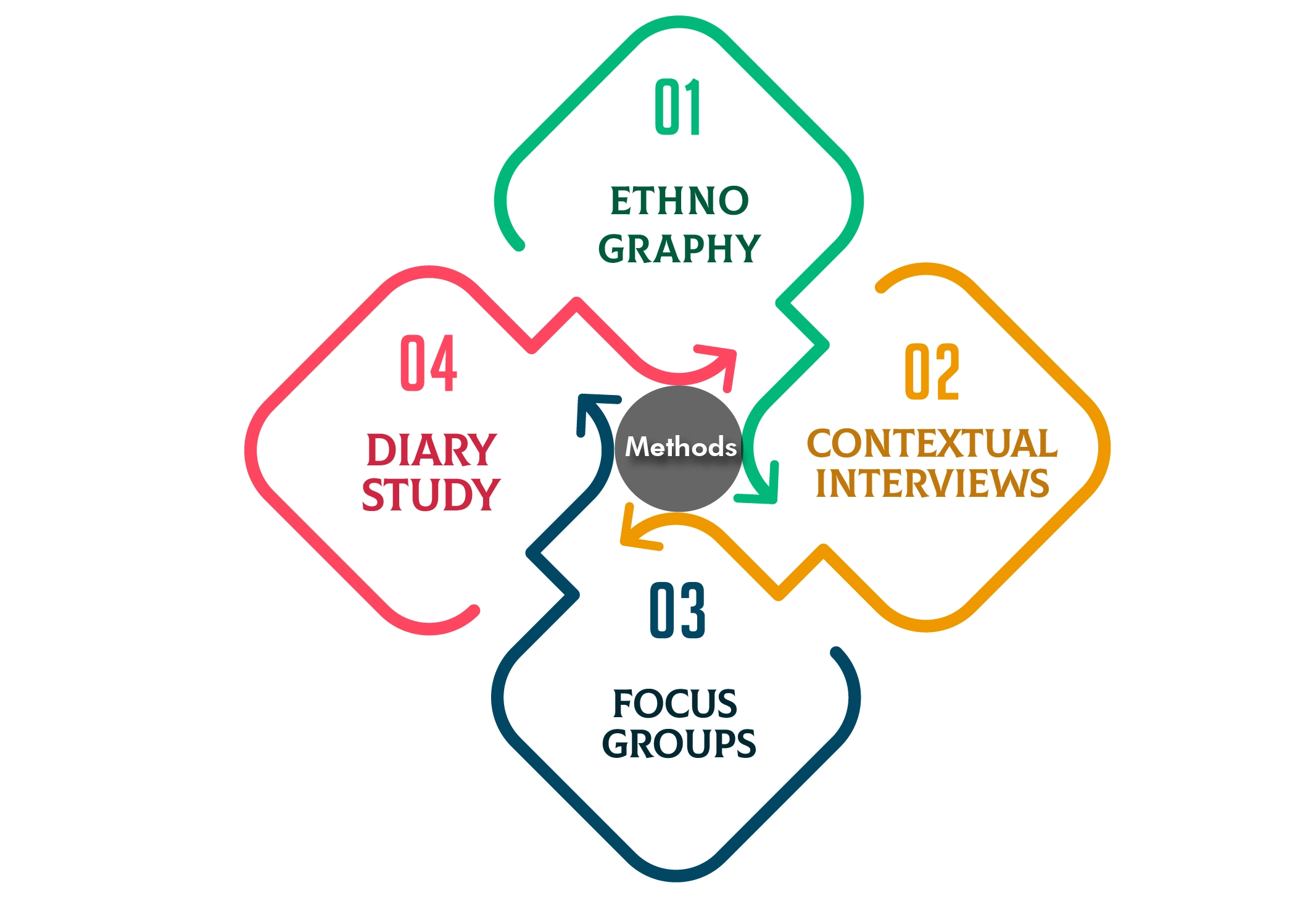Strolling Down the Overview Path of Generative Research
This terminology might seem fancy “Generative research“, but do you certainly know what exactly it is? Okay, but further discussing more about it, let’s understand one scenario here; you are a designer and you are often finding it very difficult to create a solution that aligns with a user’s needs and expectations. Then what do you do now in this certain situation? That’s where Generative research comes into the picture to save your day! Generative research is nothing but a new way or approach of a research method that brings out or generates a valuable understanding of the user’s pain point, motivations, and behavior. The major goal of this research methodology is to help the designers or product managers identify a problem statement, constructively frame all the relevant problems that need to be solved, and give an apt solution for all the problems. One fact about Generative research is also known as discovery or exploratory research.

The major key factor of the generative UX research method is that it generally aims to evaluate existing products to unwrap the audience’s and users’ motivations and objectives which are aligned with the product need. Generative research takes place at the beginning of the discovery phase of the user research process and generally takes place before creating the product. But if you are new to this field or have a curiosity to learn more about generative research and how the process development takes place, don’t worry you are in the right stage. Within this piece, we have rained down on the basic understanding of generative research, its benefits, and how to conduct an effective generative research process. Furthermore, we will be dealing with the key methods and practices of generative research as well! So without any further breaks and delays, let’s get started!
Raining the Enigma of Generative UX Research Method
Generative UX research is referred to as a qualitative research methodology that generates ideas and insights into user needs by conducting various in-depth interviews, focus groups, and ethnographic research. The practices and methods enrich the detailed analysis data about the user experiences. When we discuss the focus group methodology, users or audiences share their respective opinions on a particular product or a topic. Certainly, to conduct this method and gain a good amount of results, make sure that your focus group represents the diverse range of customers who want to interact with your brand or products. By having a discussion within a small group designers gain insights into the problems that the users are facing currently in the industry. This entire approach of conducting and gathering the data via generative research helps designers create user-centric products.

The elementary goal of the generative research method is to understand the audience or user’s past experiences, pain points, and needs which helps in analyzing the space of the problem and the root causes. This marvelous hero, generative research helps in detecting the precise problems that need to be solved to boost the overall experience. Another major goal of this research methodology is that it helps businesses, firms, or organizations to adopt a user-centric approach instead of aiming at a product-centric one. By unfolding all the curtains of the user’s objective and goals it enables designers to precisely define and understand the problems that need to be solved for the respective customers.
Exploring the Benefits of Generative User Research in Business Firms
Now let’s slightly move our vehicle towards understanding the benefits of generative user research. The first added benefit that UX generative research brings to the plate is that the idea generation to the respective designers or the product manager to open the user needs and understanding their pain points significantly brings out the creative thinking and generates better ideas that address the real user challenges and experiences that audiences face. Moreover, the second benefit on the plate is that it allows a user-centered design, the insights that are respectively collected from generative research to ensure that the design is much more oriented towards the preferences of the users will eventually lead to more user-centered and innovative solutions.

Besides, Generative research helps the design team with a dynamic foundation of user understanding that offers them informed decision-making throughout the cyclic process of the designing process. Moreover, it can also detect or identify the issues or certain misunderstandings that allow teams to address all the issues on a prior basis, hence reducing the entire risk of design changes further on in the development process. Also, generative research helps designers to create products and services that are more likely to be accomplished in the marketplace overall improving the ROI.
Digging into the Methods of Conducting UX Generative Research
So let’s now move forward to understand how to conduct effective generative user research to define any objectives and goals. To begin with, defining objectives in generative research plays a vital role as they completely describe the objective of the entire project and majorly help in focusing on what are the main goals behind the problem statement and how well it can be approached. But to certainly define the objective it is very crucial to conduct basic research in the framed problem area like what needs to be solved and gather the collective data and evidence to move forward further. Sometimes without having invaluable questions can be considered to be a waste of time at times.
So having a well-constructed objective will help someone to stay focused during the entire research cycle process, and make sure that whatever insights that have to be unlocked should be actionable and relevant to the research process. Moving forward, create a set of research plans that will help or offer you to understand and stay organized so that your crafted research is circling the right objectives and questions. A clear research plan should consist of objectives that your project needs, methodology that needs to be used, timeline, and resources to complete the entire research. Try involving all the stakeholders in the research planning process to prove the benefit as they can give beneficial input on the research objectives. Also by partnering with these stakeholder parties, one can completely rely on the generative research being consistent with the overall project objectives and goals.
The last process analyzing and synthesizing data is considered to be an important component of Generative UX research, as it allows you to identify all the patterns and the additional insights that help the entire design process. Make sure to review the collected data, identify all the patterns, and draw a conclusion line since these steps are essential to the analysis and synthesis process. This process helps to find a meaningful conclusion that is respective to the product decisions. On the other hand, synthesis data helps in combining all the data and notes gathered in the research process to build a proper set of understanding of user needs, and behavior.
Vertex of Understanding the Key Methods and Practices of Generative User Research
Let’s now focus more on how generative research and its impact on UX design makes it. Focus groups, ethnographic studies, and user interviews are some elementary methods that can be employed in Generative research. To begin with, focus groups involve gathering people together to discuss certain topics. This methodology helps to gain a better understanding of the issue that is faced by the audiences respectively and brings out a solution to tackle those certain problems and issues. The involvement of the people will be around 6-10 and make sure that questions are ready on a prior basis. This allows a comprehensive idea about users’ pain points and experiences and works effectively to develop perfect solutions.
Moreover, focus groups offer a platform where users can share their respective opinions and thoughts which will certainly help any business to create a product that truly resonates with the user’s needs and expectations. User interviews are another type of UX generative research method that is generally conducted through one-on-one methods or meetings with other participants to collect and gather all the opinions about certain topics or projects. Such interviews are conducted to allow you to have a brief insight into the user’s needs and preferences. On the other hand, ethnographic studies majorly involve monitoring people’s natural habitat and understanding their everyday activities, thoughts, and behaviors. This offers a precise understanding of the entire process and how well the product fits into their daily needs.
Summary key of Generative Research Powered by Pattem Digital
The closing thought of generative research is that it is a powerful method for all product managers and designers to better understand user needs, pain points, and motivations. Furthermore, techniques like in-depth interviews, focus groups, and ethnographic studies, generative research open doors to valuable insights that drive the creation of user-centric solutions. Generative research serves as a guiding light at the outset of the design process, illuminating the path toward problem identification and solution generation. Through this method, businesses can shift their focus from product-centric to user-centric design, fostering innovation and enhancing user experiences.
Now we are just ending our topic with Pattem Digital, an ideal UX research services company that utilizes the power of generative research to drive innovation and enhance user experiences. With a dedicated team of experts skilled in techniques like in-depth interviews, focus groups, and ethnographic studies, Pattem Digital illuminates the path toward problem identification and solution generation.





